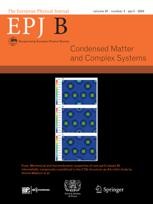Finely-tuned quantum dots enhance nonlinear optics
Quantum dots with finely-tuned spherical defects could display advanced ‘nonlinear’ optical properties, new calculations have suggested. Adjusting the sizes of these defects could enable researchers to tightly control the brightness and frequency of the light they produce when illuminated.
New York | Heidelberg, 10 February 2023
 Quantum dots are semiconductor particles measuring just a few nanometres across, which are now widely studied for their intriguing electrical and optical properties. Through new research published in EPJ B, Kobra Hasanirokh at Azarbaijan Shahid Madani University in Iran, together with Luay Hashem Abbud at Al-Mustaqbal University College, Iraq, show how quantum dots containing spherical defects can significantly enhance their nonlinear optical properties. By fine-tuning these defects, researchers could tightly control the frequency and brightness of the light emitted by quantum dots.
Quantum dots are semiconductor particles measuring just a few nanometres across, which are now widely studied for their intriguing electrical and optical properties. Through new research published in EPJ B, Kobra Hasanirokh at Azarbaijan Shahid Madani University in Iran, together with Luay Hashem Abbud at Al-Mustaqbal University College, Iraq, show how quantum dots containing spherical defects can significantly enhance their nonlinear optical properties. By fine-tuning these defects, researchers could tightly control the frequency and brightness of the light emitted by quantum dots.
The duo’s discoveries could lead to new advances in ‘optoelectronic’ devices including LEDs and light-based computer circuits – which operate through the interaction between light and electricity. If achieved, improvements to this technology could significantly boost the speed of computing and communications systems.
Nonlinear optical properties can arise in some materials when they are illuminated with intense light – producing new photons with identical frequencies and waveforms to the original light. Increasingly, researchers are exploring the potential of ‘third-order’ nonlinear optical processes – which generate photons with triple the frequency of the original light. Recent studies have shown that these processes are readily triggered in spherical quantum dots, containing spherical defects in the structure of their atomic lattices.
Leading on from this research, Hasanirokh and Abbud explored how third-order nonlinear susceptibility can be controlled by varying the numbers and sizes of these defects. In their study, the duo used mathematical techniques to consider multi-layered quantum dots – containing a cadmium sulphide core and a zinc sulphide outer shell. These layers were separated by a spherical defect – containing a carefully-adjusted mixture of cadmium, zinc, and sulphur.
By fine-tuning this structure, the researchers calculated that its third-order nonlinear optical properties could be considerably enhanced – allowing them to tightly control the brightness and frequency of the light produced. They now hope their results could inspire new techniques for quantum dot manufacturing, which could bring their advanced theoretical structure into reality.
Reference: Hasanirokh, K., Abbud, L.H. Third-order nonlinear susceptibility in CdS/Cdx1Zn1-x1S/ZnS multilayer spherical quantum dot. Eur. Phys. J. B 96:5 (2023). https://doi.org/10.1140/epjb/s10051-022-00464-0
Further Information
For more information visit: www.epj.org
Services for Journalists
The full-text article is available here.
Contact
Sabine Lehr | Springer | Physics Editorial Department
tel +49-6221-487-8336 | sabine.lehr@springer.com
